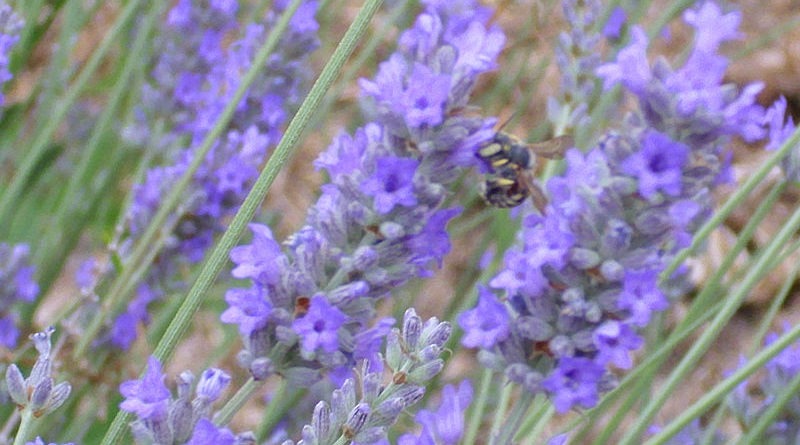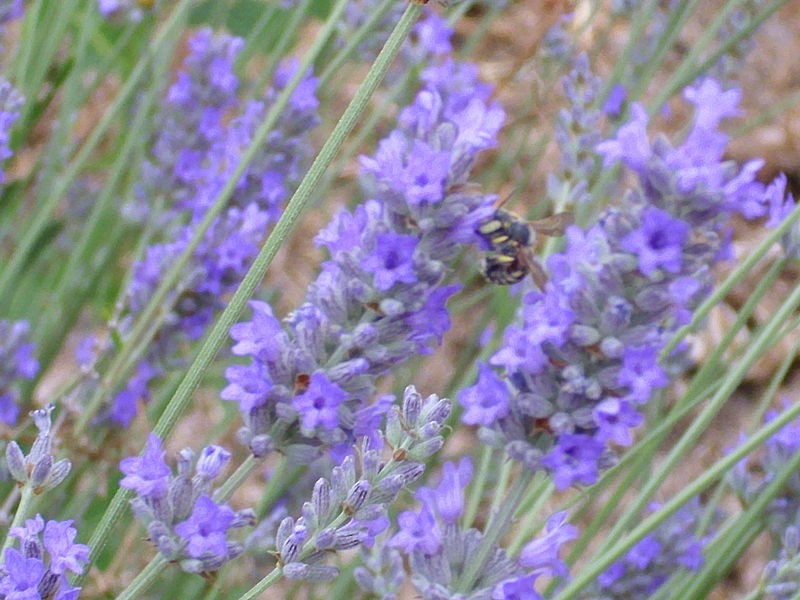
Oil of Spike Lavender Research & References
 This annotated list of references includes studies on: 1) inhalation of oil of spike lavender (L. latifolia), and 2) inhalation of the lavender species in general.
This annotated list of references includes studies on: 1) inhalation of oil of spike lavender (L. latifolia), and 2) inhalation of the lavender species in general.
Some studies on lavenders other than spike lavender are listed because of the similarity of components across the species. The lavender family has over 30 varieties, dozens of subspecies, and hundreds of hybrids and selected cultivars – all with with similar components varying in percentage. Even in the same subspecies there is slight variation from crop to crop and farm to farm, so it is impossible to consistently calculate the exact content of any one taxonomic unit over an extended period of time. Therefore a somewhat broader survey of the research such as this may be appropriate. This list is for educational purposes only.
Buchbauer G, Jirovetz L, Jäger W, Dietrich H, Plank C. Aromatherapy: evidence for sedative effects of the essential oil of lavender after inhalation. Z Naturforsch . 1991;46(11-12):1067-1072.
Evidence of the aromatherapeutical use of lavender employed in folk medicine since ancient times in order to facilitate falling asleep or to minimize stressful situations.
Fujii M, Hatakeyama R, Fukuoka Y, et al. Lavender aroma therapy for behavioral and psychological symptoms in dementia patients. Geratr Geronotol Int . 2008;8(2):136-138.
Lavender oil did not prove superior to the control oil in reducing the frequency of physically agitated behaviours or in improving participants’ affect.
Gedney JJ, Glover TL, Fillingim RB. Sensory and affective pain discrimination after inhalation of essential oils. Psychosomatic Med . 2004;66(4):599-606.
These findings suggest that aromatherapy may not elicit a direct analgesic effect but instead may alter affective appraisal of the experience and consequent retrospective evaluation of treatment-related pain.
Henley DV, Lipson N, Korach KS, Bloch CA. Prepubertal gynecomastia linked to lavender and tea tree oils. N Engl J Med . 2007;356(5):479-485.
This is a controversial study that involved only three adolescent boys and no controls. The conclusions have been contradicted by more recent research.
Kritsidima M, Newton T, Asimakopoulou K. The effects of lavender scent on dental patient anxiety levels: a cluster randomised-controlled trial. Community Dent Oral Epidemiol . 2010;38(1):83-87.
Analyses of variance showed that although both groups showed similar, moderate levels of generalized dental anxiety the lavender group reported significantly lower current anxiety than the control group.
Landelle C, Francony G, Sam-Laï NF, et al. Poisoning by lavandin extract in a 18-month-old boy. Clin Toxicol (Phila) . 2008;46(4):279-281.
This is the only case of lavandin extract poisoning confirmed by toxicological analysis. The child ingested homemade lavandin (different subspecies than L latifolia). His neurological state normalized within 6 hours of ingestion.
Lee IS. Effects of lavender aromatherapy on insomnia and depression in women college students. Taehan Kanho Hakhoe Chi. 2006 Feb;36(1):136-43.
According to the study results, it can be concluded that the lavender fragrance had a beneficial effect on insomnia and depression in women college students. Repeated studies are needed to confirm effective proportions of lavender oil and carrier oil for insomnia and depression.
Lin PW, Chan WC, Ng BF, Lam LC. Efficacy of aromatherapy ( Lavandula angustifolia ) as an intervention for agitated behaviours in Chinese older persons with dementia: a cross-over randomized trial. Int J Geriatr Psychiatry . 2007;22(5):405-410.
Lavender is effective as an adjunctive therapy in alleviating agitated behaviours in Chinese patients with dementia. In a patient population particularly vulnerable to side effects of psychotropic medications, aromatherapy using lavender may offer an alternative option.
Lopez V. In vitro antioxidant and anti-rhizopus activities of Lamiaceae herbal extracts. Plant Foods Hum Nutr. 2007 Dec;62(4):151-5. Epub 2007 Oct 3.
Spike lavender (L. latifolia) showed in vitro antioxidant activity.
Nord D, Belew J. Effectiveness of the essential oils lavender and ginger in promoting children’s comfort in a perianesthesia setting. J Perianesth Nurs . 2009;24(5):307-312.
The mean distress level was lower for the children in the essential oil group, but the effect was not statistically significant (P = .055).
Roller S. The antimicrobial activity of high-necrodane and other lavender oils on methicillin-sensitive and -resistant Staphylococcus aureus (MSSA and MRSA). J Altern Complement Med. 2009 Mar;15(3):275-9. doi: 10.1089/acm.2008.0268.
The results suggest that combinations of lavender oils, including spike lavender (L. latifolia), should be investigated further for possible use in antibacterial products.
Rota C. In vitro antimicrobial activity of essential oils from aromatic plants against selected foodborne pathogens. J Food Prot. 2004 Jun;67(6):1252-6.
Some essential oils, including spike lavender (L. latifolia), were highly inhibitory in small quantities to selected pathogenic microorganisms, they may provide alternatives to conventional antimicrobial additives in foods.
Shimada K, Fukuda S, Maeda K, et al. Aromatherapy alleviates endothelial dysfunction of medical staff after night-shift work: preliminary observations. Hypertens Res . 2011;34(2):264-267.
This study demonstrated that night-shift work impaired endothelial function in medical staff, an effect that was alleviated by short-term lavender aromatherapy.
Shiina Y, Funabashi N, Lee K, et al. Relaxation effects of lavender aromatherapy improve coronary flow velocity reserve in healthy men evaluated by transthoracic Doppler echocardiography. Int J Cardiol . 2008;129(2):193-197.
Lavender oil did not prove superior to the control oil in reducing the frequency of physically agitated behaviours or in improving participants’ affect.
Umezu T. Anticonflict effects of lavender oil and identification of its active constituents. Pharmacol Biochem Behav. 2006 Dec;85(4):713-21. Epub 2006 Dec 14.
The study concluded that linalool, the active ingredient in spike lavender (L. latifolia), is the major pharmacologically active constituent involved in the anti-anxiety effect of lavender oils.
van der Ploeg ES, Eppingstall B, O’Connor DW. The study protocol of a blinded randomised-controlled cross-over trial of lavender oil as a treatment of behavioural symptoms in dementia. BMC Geriatr . 2010;10:49.
Results show that the use of lavender oil is effective in reducing challenging behaviours in individuals with dementia, it will potentially provide a safer intervention rather than reliance on pharmacology alone.
U.S. Food and Drug Administration. CFR – Code of Federal Regulations Title 21. Food and Drug Administration Web site. http://www.accessdata.fda.gov/scripts/cdrh/cfdocs/cfcfr/CFRSearch.cfm?CFRPart=182&showFR=1 . Accessed December 5, 2010.
GENERALLY RECOGNIZED AS SAFE for their intended use, within the meaning of section 409 of the Act, includes Lavender, spike (Lavandula latifolia Vill.). Importantly, GENERALLY RECOGNIZED AS SAFE (GRAS) is a USFDA designation that a chemical or substance added to food (i.e., food additive) is considered safe by experts, and so is exempted from the usual Federal Food, Drug, and Cosmetic Act (FFDCA, the Act) food additive tolerance requirements.
Williams TI. Evaluating effects of aromatherapy massage on sleep in children with autism: a pilot study. Evid Based Complement Alternat Med . 2006;3(3):373-377.
The results suggest that the use of aromatherapy massage with lavender oil has no beneficial effect on the sleep patterns of children with autism attending a residential school. It is possible that there are greater effects in the home environment or with longer-term interventions.
